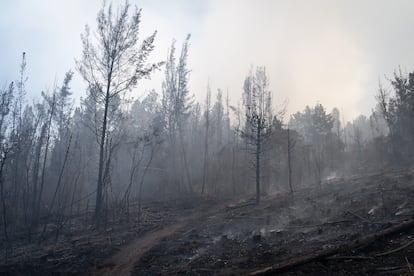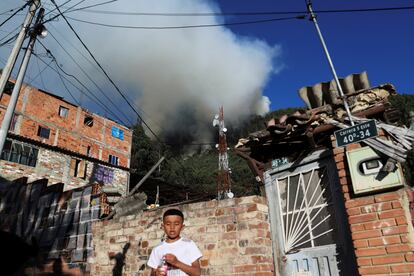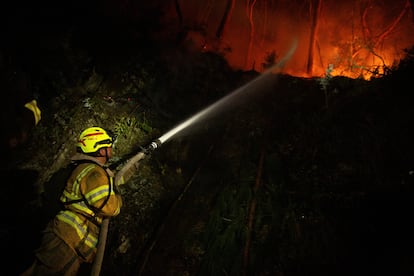The El Niño phenomenon and dry season join forces to set Colombia on fire
Multiple experts agree that extreme aridity and lack of rainfall have combined to cause over 500 forest fires so far this year. They warn that these conditions will continue until April

Colombia has been on fire for almost a week. This Thursday alone there were 31 active forest fires in the country, according to the National Unit for Disaster Risk Management (UNGRD). These are unprecedented figures. Between January 1 and 23, 508 forest fires were recorded, 200 more than at the same time last year, according to the National Fire Department. And the authorities warn that they will not stop until April, when the rains return. According to several experts, at the moment three factors are converging to make Colombia particularly vulnerable: the usual dry season, a strong El Niño phenomenon and very high temperatures due to climate change. It is the perfect recipe for a country to catch fire, explains Johana Herrera, World Wildlife Fund Colombia’s forest and climate change officer, by telephone.
“There is a very well-defined weather pattern in Colombia,” Herrera says. From December to April, and from June to September, there are two dry seasons, with little rainfall. The rainy seasons occur from April to May, and from October to December. It is normal, then, that the first weeks of the year are sunny. But this year the lack of rainfall has been greater than usual. For example, the capital city has now gone nine consecutive days with less than 0.2 mm of rain, according to the District Institute for Risk Management and Climate Change (IDIGER). And the people of Bogota are suffering.
At the beginning of the week, a forest fire in the Cerros Orientales filled the northeast of the city with a strong burning smell. Authorities extinguished it on Wednesday, after fighting it for two days. But several more fires had already started in other areas and, hours later, in another section of the same mountains, El Cable, burst into flames. It is not just a problem in Bogota. Herrera says that El Niño’s arrival has exacerbated the aridity of this dry season and turned much of Colombia into a tinderbox.

What is El Niño?
Yolanda González is director of the El Niño Research Center (CIIFEN) and headed Colombia’s state-run Institute of Hydrology, Meteorology and Environmental Studies (IDEAM) for four years. “It is normal for El Niño to result in more forest fires,” she tells this newspaper. It is a cyclical phenomenon that occurs due to the warming of the tropical Pacific Ocean. Together, El Niño and La Niña, the opposite phase, are the cause of the greatest sign of climate variability in the tropical Pacific strip.
El Niño manifests in two ways, depending on the region. In Peru it means rain, while in Colombia, especially in high mountain areas, it usually causes droughts. During this dry season, the phenomenon “is creating conditions conducive to fires.” In addition to the thirty fires, 28 of the 32 departments are on alert for forest fires. Over half of the country’s 1,102 municipalities are on high alert.

El Niño is a cyclical natural phenomenon that alternates with periods of normality and La Niña. It usually occurs every four years, but lately it has been occurring more frequently. “It has a tendency to become stronger and stronger. Climate change is strengthening the impacts of El Niño, as well as its frequency and intensity,” says Gonzalez.
The population’s responsibility
In these conditions that are so conducive to fires, experts agree that the population has a great responsibility to prevent them. According to the Ministry of the Environment, 95% of the fires in Colombia are caused by human beings. Most of them start due to “human beings’ carelessness, imprudence, lack of attention or irresponsibility,” the Ministry says. Herrera adds that many of these disasters occur in remote areas, where roads are precarious and access is difficult for firefighters and rescue workers.
To prevent more areas in the countryside from catching fire, the forestry engineer urges Colombians: “Avoid burning. Do not burn garbage, do not throw cigarette butts in areas where there is vegetation. Do not light gunpowder or balloons with wicks. It is very dangerous.” Juan Carlos Orrego, an expert in risk management and climate change adaptation at the Red Cross Bogotá, echoes this message, adding that it is important not to leave bottles or glass items that can produce fire in natural areas.
The local and national governments also have a responsibility. They control everything related to risk management, Herrera points out. “They have to take action to avoid or prevent these fires. That requires work agreements and investment,” he says. For his part, Orrego calls on the authorities to prepare protocols for accessing the sites when a fire breaks out. “The first minutes are of vital importance for limiting it and defining the approach strategy,” he says in a video shared with the media.

Faced with the growing threat of fires, President Gustavo Petro has announced that Colombia will ask the UN for help. “We activated all protocols to seek international assistance. To the extent that we know that crisis events are going to increase, we want to be sure that we have the physical capacity to address and mitigate them,” he said on Thursday at a press conference from Tumaco (Nariño), Colombia. Petro adds that “at this moment, practically all [our] physical capacity — over 600 men trained to put out fires — are on the ground.”
Like the experts, the president also predicts that the current situation will last for at least two more months. And he warns that it will continue to worsen. “We are heading for an increasingly tougher stage. The prediction for this weather crisis is that it will go through the whole month of February and a good part of March. We expect the end of March to be the end of the cycle,” he said.
Sign up for our weekly newsletter to get more English-language news coverage from EL PAÍS USA Edition
Tu suscripción se está usando en otro dispositivo
¿Quieres añadir otro usuario a tu suscripción?
Si continúas leyendo en este dispositivo, no se podrá leer en el otro.
FlechaTu suscripción se está usando en otro dispositivo y solo puedes acceder a EL PAÍS desde un dispositivo a la vez.
Si quieres compartir tu cuenta, cambia tu suscripción a la modalidad Premium, así podrás añadir otro usuario. Cada uno accederá con su propia cuenta de email, lo que os permitirá personalizar vuestra experiencia en EL PAÍS.
¿Tienes una suscripción de empresa? Accede aquí para contratar más cuentas.
En el caso de no saber quién está usando tu cuenta, te recomendamos cambiar tu contraseña aquí.
Si decides continuar compartiendo tu cuenta, este mensaje se mostrará en tu dispositivo y en el de la otra persona que está usando tu cuenta de forma indefinida, afectando a tu experiencia de lectura. Puedes consultar aquí los términos y condiciones de la suscripción digital.
More information
Archived In
Últimas noticias
What is known about the Interoceanic Train derailment in Oaxaca
Trump turns a Minnesota fraud allegation into ammunition for his MAGA army against Democrats
The year Trump created 1.6 million undocumented immigrants
Russia threatens to break off negotiations after accusing Ukraine of attacking one of Putin’s residences
Most viewed
- Reinhard Genzel, Nobel laureate in physics: ‘One-minute videos will never give you the truth’
- Oona Chaplin: ‘I told James Cameron that I was living in a treehouse and starting a permaculture project with a friend’
- Pablo Escobar’s hippos: A serious environmental problem, 40 years on
- Chevy Chase, the beloved comedian who was a monster off camera: ‘Not everyone hated him, just the people who’ve worked with him’
- Why we lost the habit of sleeping in two segments and how that changed our sense of time











































